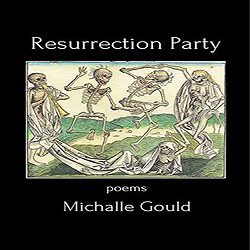
Death is always simple. Death is never, ever simple; the pieces, the rites, the mourners, the sites and sights all enshrined and coded and occasionally euthanized by a good bit of religion. Resurrection Party by Michalle Gould tries to capture this last, eternal, desperate promise of God and priests – the promise that we will, one day, return – and capture it in an Eliot-esque, surrealism-of-the-everyday setting.
To be frank, it’s a struggle. It would be for anybody.
Gould is multitalented, a prose and poetry author whose work has been recognized by such personal favorites as Slate and the American Literary Review. Her poetry flashes into luminescence in the moments that it recognizes the balance between her arts; experimentation with rhyme and flat, rhythmic prose style coalesce into the gorgeousness that becomes the last poem in the book, What it Means to Be Alive at the Time of the Resurrection of the Dead. To quote:
No one tells you it’s here.
A perfunctory knock on the door
awaits no answer, they enter
and crowd at your table, their
boots are damp and spore-
ridden. “Hard work,” says your father,
As one of the moments Gould steps away from hard rhyme or flat prosaicism, this is one of the triumph poems of Resurrection Party, one of the moments that it fulfills its Eliot- and Brimhall-like calling while remaining strikingly original and strangely moving in its defamiliarization of everyday life.
There are more than a handful of triumph poems: What it Means to Be Alive, On the Potential Appearance of Resurrection, When I Was Naked, Self-Portrait as an Ampoule of Martyr’s Blood Buried with Them in Their Tomb all represent moments when Gould combines simplicity and wonder into moments that raise even religion higher. Although these poems form the lyrical rather than the numerical backbone of the book, they evidence a growth and potential that will surely continue to develop and should be watched closely.
Outside of these moments of triumph – these moments where everything comes together in a seemingly-effortless flow – there are moments of bravery that must also be examined.
The snow comes heaven-faced like a bride.
It cleaves to the nakedness of the frame.
The pigeons have left us. The house is quiet and empty.
I am no maker of arks. I should not have dared to build
anything.
The loneliness and defiance that mark these passages of I am the architect (not the builder) demand to be recognized![gould[1]](https://therumpus.net/wp-content/uploads/2015/02/gould1-300x300.jpg) in the best possible way, striking examples of a fragile independence borne of the necessity that death creates, emphasizing Gould’s message strikingly and unforgettably. While some of Gould’s imagery and framing struggles to strike impossible chords too neatly – the beginning of I am the architect includes a hot air balloon image that doesn’t quite seem to fit the narrative arc nor overall pioneering, wood-fire-and-forest imagery of the poem – others hit the sort of mystical logic and recalcitrance of religion.
in the best possible way, striking examples of a fragile independence borne of the necessity that death creates, emphasizing Gould’s message strikingly and unforgettably. While some of Gould’s imagery and framing struggles to strike impossible chords too neatly – the beginning of I am the architect includes a hot air balloon image that doesn’t quite seem to fit the narrative arc nor overall pioneering, wood-fire-and-forest imagery of the poem – others hit the sort of mystical logic and recalcitrance of religion.
And Resurrection Party is quite clearly steeped in religion, steeped in all kinds of academia. Shot through with plague-era illustrations that seem almost too macabre for the normalized settings of death and grief, Gould’s book is a compact thing, but manages to touch upon Helen of Troy and cellular logic in a single poem, as well as bring in musings on Rapunzel and various artists – Matisse and Michelangelo, to name a few. While some of these clippings could lend a fervent blood to the poem, many seem to focus slightly too heavily on explaining rather than expanding upon their subject matter:
While the body largely reclines, a letter K
lain on its side and slightly bent,
or in a less common pose, my back faces the viewer
so I resemble a pushed in O
Gould clearly has an incredible grasp of music; her assonance and interior rhyme are compelling, a luxury of sound. But rather than use that wonderful grip of sound for evocative, original images, we are temporarily left with alphabetic bodies. Gould is clearly more capable than this, as can be seen in other iterations of her work.
Gould is clearly an incredibly talented poet; Resurrection Party is full of fragments of beauty. But many of the wonderful moments of her poem seem to be at odds with each other, temporarily suspended. I will look forward to the next book of work by this poet, as Resurrection Party is already a wonderful movement and effect of progress. But it is progress – the skeletons moving out of the grave, but not quite yet to the new horizon.




